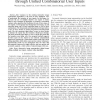Free Online Productivity Tools
i2Speak
i2Symbol
i2OCR
iTex2Img
iWeb2Print
iWeb2Shot
i2Type
iPdf2Split
iPdf2Merge
i2Bopomofo
i2Arabic
i2Style
i2Image
i2PDF
iLatex2Rtf
Sci2ools
TIP
2010
2010
User-Friendly Interactive Image Segmentation Through Unified Combinatorial User Inputs
One weakness in the existing interactive image segmentation algorithms is the lack of more intelligent ways to understand the intention of user inputs. In this paper, we advocate the use of multiple intuitive user inputs to better reflect a user's intention. In particular, we propose a constrained random walks algorithm that facilitates the use of three types of user inputs: (1) foreground and background seed input, (2) soft constraint input, and (3) hard constraint input, as well as their combinations. The foreground and background seed input allows a user to draw strokes to specify foreground and background seeds. The soft constraint input allows a user to draw strokes to indicate the region that the boundary should pass through. The hard constraint input allows a user to specify the pixels that the boundary must align with. Our proposed method supports all three types of user inputs in one coherent computational framework consisting of a constrained random walks and a local edi...
Related Content
| Added | 22 May 2011 |
| Updated | 22 May 2011 |
| Type | Journal |
| Year | 2010 |
| Where | TIP |
| Authors | Wenxian Yang, Jianfei Cai, Jianmin Zheng, Jiebo Luo |
Comments (0)

